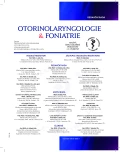The Brno Cochlear Implant Centre: The Treatment Outcomes of Unilateral Cochlear Implantations in Adults
Authors:
B. Gál 1; R. Kostřica 1; J. Hložek 1; T. Talach 1; J. Rottenberg 1; M. Veselý 1; I. Šlapák 2; M. Urík 2; D. Hošnová 1,2; J. Čefelínová 3; I. Horová 4; M. Budíková 4
Authors‘ workplace:
Klinika otorinolaryngologie a chirurgie hlavy a krku, Lékařská fakulta Masarykovy univerzity a Fakultní nemocnice u sv. Anny v Brně
1; Klinika dětské ORL, Lékařská fakulta Masarykovy univerzity a Fakultní nemocnice Brno :
2; Oddělení klinické logopedie, Lékařská fakulta Masarykovy univerzity a Fakultní nemocnice u sv. Anny v Brně
3; Ústav matematiky a statistiky, Přírodovědecká fakulta Masarykovy univerzity v Brně
4
Published in:
Otorinolaryngol Foniatr, 68, 2019, No. 1, pp. 18-23.
Category:
Original Article
Overview
Objective: The study objective is to analyze the treatment outcomes of unilateral cochlear implantation (CI) in adult patients at the Department of Otorhinolaryngology and Head and Neck Surgery, St. Anne’s University Hospital in Brno.
Methods: A retrospective analysis was conducted to the patient group in which the unilateral CI was performed in the period from 6/2012 to 4/2018. Total number of patients: 74; 32 men (43%), 42 women (57%); mean age 42 years (18-87 years).
Results: Pure tone threshold audiometry: pure tone average (PTA) preoperatively: 100,7±11,0 dB HL, postoperatively: 40,2±8,4 dB HL, mean pre and postoperative difference: 60,6±14,4 dB HL; (p< 0.01). Speech audiometry (SA): mean maximal speech recognition threshold preoperatively: 9,2±15,3%, postoperatively: 56,8±19,0%, mean pre and postoperative difference: 47,4±22,1%; (p< 0.01). The evaluation of communication skill according to Nottingham scale: grade 7 in 17 patients (23%), grade 6 in 27 (36%), grade 3 in 17 (23%), grade 4 in 9 (12%), grade 3 in 3 (4%) and grade 2 in 1 (1%). The CI result breakdown by type of history: group 1 (n=31): a group with slowly progressive hearing loss corrected by hearing aid; group 2 (n=25): a group with no hearing stimulation for more than 5 years; no significant difference in outcome was found in terms of PTA results and speech recognition; (p>0.05). The CI result breakdown by age at the time of operation: 3 groups: 1. <50 years, 2. 50-65 years, 3. >65 years; no significant difference in postoperative results was found regarding PTA and speech audiometry results; (p>0.05).
Conclusion: In postlingually deaf patients who do not benefit from hearing aid fitting, the unilateral cochlear implantation represents a highly efficient option to improve the hearing function. Our analysis proves the significant improvement in speech recognition and verbal communication without lip-reading which brings a remarkable benefit in life quality.
Keywords:
hearing loss – pure tone average – speech recognition threshold – unilateral cochlear implantation – efficacy of cochlear implantation
Sources
1. Betka, J., Valvoda, M., Hrubý, J. et al.: Surgical procedure and results of implantation of the Czech cochlear neuroprosthesis. Czech Med., 13, 1990, 2-3, s. 124-130.
2. Cohen, S. M., Labadie, R. F., Dietrich, M. S. et al.: Quality of life in hearing-impaired adults: the role of cochlear implants and hearing aids. Otolaryngol. Head Neck Surg., 131, 2004, s. 413-422.
3. Černý, L., Skřivan J:. Kochleární a kmenová implantace u dospělých – výsledky. Otorinolaryng. a Foniat. /Prague/, 56, 2007, 4, s. 191-194.
4. Djalilian, H. R., King, T. A., Smith, S. L. et al.: Cochlear implantation in the elderly: results and quality-of-life assessment. Ann. Otol. Rhinol. Laryngál., 111, 2002, s. 890-895.
5. Dlouhá, O., Novák, A., Vokřál, J.: Česká slovní audiometrie – vývoj nových testů. Otorinolaryng. a Foniat. /Prague/, 57, 2008, 4, s. 195-200.
6. Francis, H. W., Yeagle, J. D., Brightwell, T.: Central effects of residual hearing: Implications for choice of ear for cochlear implantation. Laryngoscope, 114, 2004, 10, s. 1747-1752.
7. Hawthorne, G., Hogan, A., Giles, E.: Evaluating the health-related quality of life effects of cochlear implants: a prospective study of an adult cochlear implant program. Int. J. Audio., 43, 2004, 4, s. 183-192.
8. Indikační kritéria pro implantovatelné sluchové pomůcky [online]. Dostupné z URL: http://www.otorinolaryngologie.cz/dokumenty/indikace.pdf.
9. Laske, R. D., Veraguth, D., Dillier, N. et al.: Subjective and objective results after bilateral cochlear implantation in adults. Otol. Neurotik., 30, 2009, s. 313-318.
10. Raman, G., Lee, J., Chung, M. et al.: Effectiveness of cochlear implants in adults with sensorineural hearing loss. Rockville, MD: Agency for Healthcare Research and Quality, 2011, Contract 290200710055.
11. Salthouse, T. A.: Aging and measures of processing speed. Biol Psychol, 54, 2000, 1-3, s. 35-54.
12. Vermeire, K., Brokx, P. L., Wuyts, F. L.: Quality of life benefit from cochlear implantation in the elderly. Otol. Neurotik., 26, 2005, s. 188-195.
13. UK Cochlear Implant Study Group. Criteria of candidacy for unilateral cochlear implantation in postlingually deafened adults III: prospective evaluation of an actuarial approach to defining a criterion. Ear Hear, 25, 2004, 4, s. 361-374.
Labels
Audiology Paediatric ENT ENT (Otorhinolaryngology)Article was published in
Otorhinolaryngology and Phoniatrics

2019 Issue 1
Most read in this issue
- Congenital Stridor
- Asymmetric Hearing Loss
- Cholesteatoma Behind an Intact Tympanic Membrane – Retrospective Study
- Tumor Microenvironment
